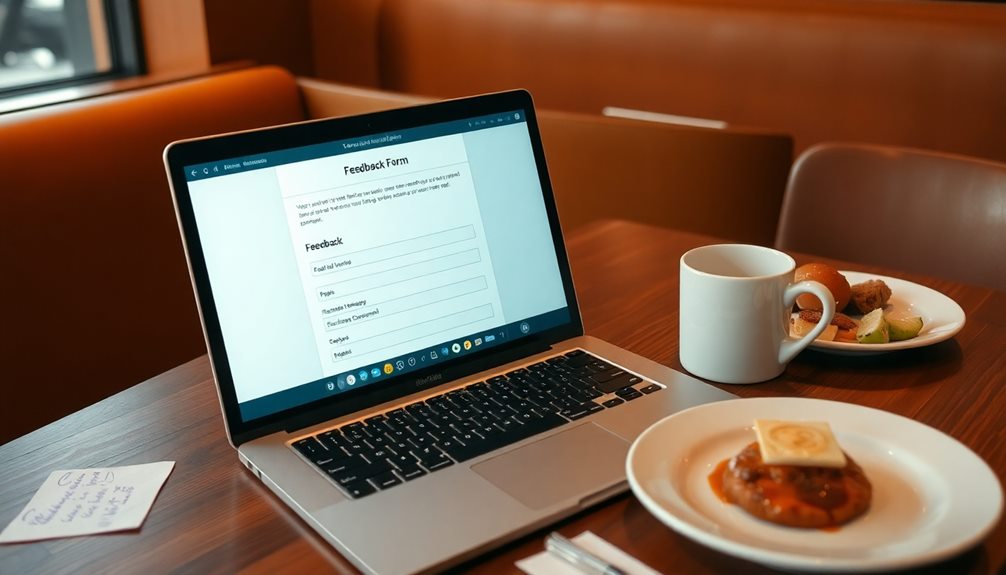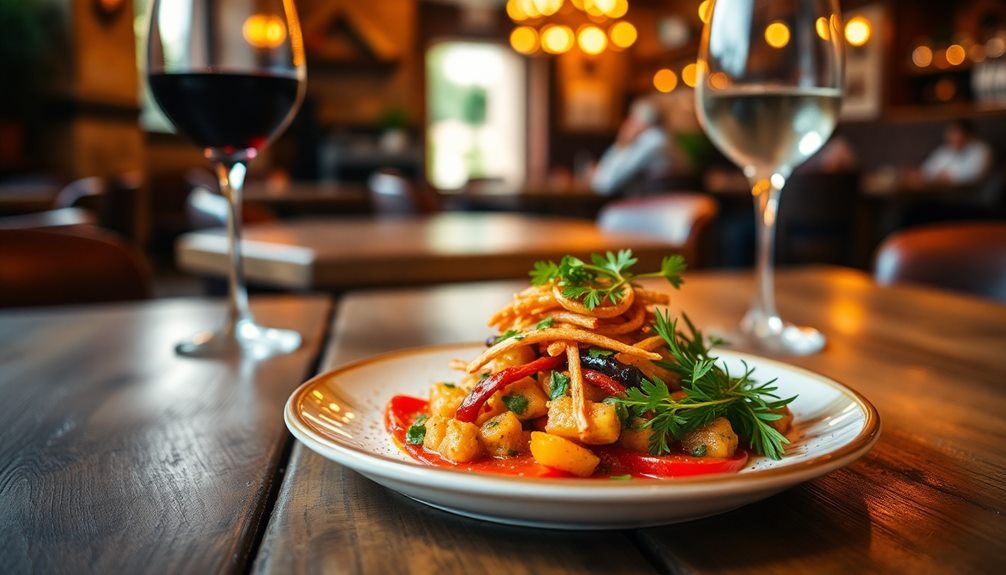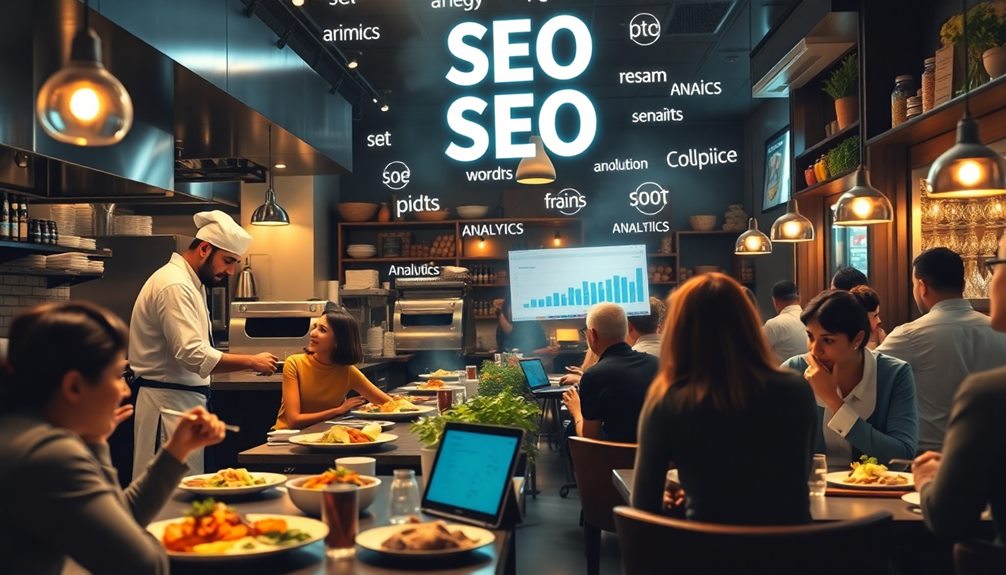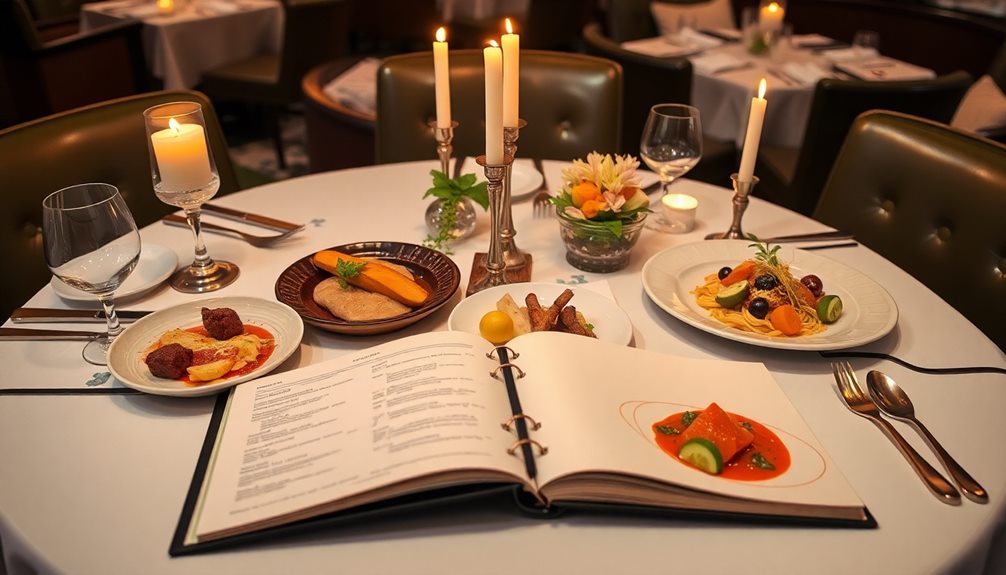To create a restaurant website, start by gathering inspiration and planning your content. Focus on key pages like the Homepage, Menu, Reservations, and Contact. Choose a template that reflects your brand and is mobile-responsive. Establish a strong visual identity with a unique logo and a cohesive color palette. Make sure you integrate online reservation systems and high-quality images to entice visitors. Don't forget about search engine optimization to help customers find you. Finally, promote your site through social media and analyze performance metrics. There's much more to explore about each of these steps!
Key Takeaways
- Gather inspiration and ideas by researching web design trends and analyzing competitor websites for effective features and layouts.
- Plan essential website content, including a Homepage, Menu, Gallery, Reservations, and Contact pages to guide visitors.
- Choose a suitable and mobile-responsive template that reflects your restaurant's branding and cuisine style for optimal user experience.
- Establish a cohesive brand identity with a unique logo, color palette, and typography to enhance recognition and customer trust.
- Ensure mobile responsiveness by implementing responsive design and simplifying navigation for easy access on all devices.
Gather Inspiration and Ideas

When you're creating a restaurant website, gathering inspiration and ideas is essential to set your brand apart. Start by researching the latest web design trends; they can provide fresh visual inspiration to keep your site competitive.
Take a close look at your local competitors' websites, too. Analyze what features resonate with your target audience and note effective practices that you can adopt. Additionally, consider how you can utilize targeted promotions to enhance your visibility and draw in customers.
Reviewing restaurant website templates is another great way to enhance your design. These templates can offer valuable insights into layout and navigation, ultimately improving user experience.
Pay attention to appealing elements on successful sites, like color schemes and typography, which can greatly influence how visitors perceive your brand.
Don't hesitate to brainstorm unique concepts for your website's layout and visuals. Think about how you can create a memorable online presence that stands out from the crowd.
Plan Your Website Content

After gathering inspiration and ideas, the next step is to plan your website content effectively. Start by identifying vital pages for your restaurant website, like the Homepage, Menu, Gallery, Reservations, and Contact page. Each page serves a purpose, providing important information that guides visitors through your offerings.
Your Menu page should feature detailed descriptions and prices for each dish, as menu items greatly influence customer decisions. Make it easy for potential patrons to envision their dining experience.
Use high-quality images in your Gallery to showcase both the atmosphere of your restaurant and the delicious dishes you serve. Visual appeal is essential for attracting customers.
Don't forget to integrate a reservations system. This feature allows for easy table bookings and enhances user experience, increasing the likelihood of reservations.
Choose a Suitable Template

When you choose a template for your restaurant website, make sure it reflects your branding and cuisine style.
You'll also want it to be user-friendly and mobile-responsive, as many customers will browse on their phones.
Consider how easily you can customize the template to adapt as your restaurant evolves.
Template Design Considerations
Choosing the right template for your restaurant website is essential to creating an inviting online presence that reflects your brand and cuisine. When considering template design, focus on how well it aligns with your restaurant branding. A cohesive look can attract and retain customers.
Additionally, consider incorporating features that enhance user experience, such as top projectors for gaming enthusiasts to capture attention with engaging visuals.
Mobile responsiveness is a must. With over 50% of web traffic coming from mobile devices, your site should provide a seamless experience across all platforms. Opt for a user-friendly template that allows for easy customization, so you can update content without needing extensive technical skills.
Incorporate essential features like online ordering and reservations. These functionalities not only enhance user engagement but also streamline operations, making it easier for customers to interact with your restaurant.
Additionally, look for templates that support social media integration, encouraging visitors to connect with you on various platforms.
Lastly, research and compare options across different website builders. Platforms like WordPress and UpMenu offer a wide range of pre-designed templates that can save you time and elevate your website's design quality.
Make informed choices to guarantee your restaurant website stands out in the digital landscape.
Customization Options Available
With a variety of customization options available, selecting the right template for your restaurant website can greatly enhance your brand's online presence.
Start by choosing a template that aligns with your brand's cuisine and ambiance, helping to create a cohesive visual identity. Look for templates with customizable features that allow you to adjust colors, fonts, and layouts, ensuring your site reflects your restaurant's unique style.
It's also important to select a mobile-responsive template. A significant portion of your traffic will come from smartphones and tablets, so a seamless browsing experience is key.
Prioritize templates that include essential pages like Menu, Reservations, and Contact. This streamlines the user experience, making essential information easily accessible for your customers.
Mobile Responsiveness Importance
Selecting a mobile-responsive template is essential for your restaurant website. With over 50% of web traffic coming from mobile devices, ensuring mobile responsiveness directly impacts user engagement and retention. A good template automatically adjusts layout and content to fit various screen sizes, providing a seamless viewing experience for visitors using smartphones and tablets.
Google prioritizes mobile-friendly websites in search rankings, which is vital for your restaurant's visibility and potential customer acquisition. If your website isn't mobile-responsive, you risk losing traffic to competitors who are.
Using a responsive template can also reduce bounce rates; when visitors find your site easy to navigate on their devices, they're more likely to stay longer and explore your offerings.
Fortunately, many modern website builders, like Wix and UpMenu, come with built-in mobile optimization features. These tools simplify the process of creating a mobile-friendly restaurant website, allowing you to focus on what matters most—serving delicious food and providing excellent service.
Don't underestimate the importance of mobile responsiveness; it's a key factor in attracting and retaining customers in today's digital landscape.
Establish Your Branding

To establish your branding, start by defining your brand identity with a unique logo that captures your restaurant's theme and values.
Next, choose a color palette that reflects the emotions you want to evoke and select fonts that enhance readability while showcasing your personality.
These elements will create a cohesive look that builds trust and recognition among your customers.
Define Brand Identity
Creating a strong brand identity is essential for your restaurant's success. Start by developing a unique logo that captures your restaurant's theme, enhancing brand recognition and serving as a visual anchor for customers. Your restaurant name should resonate with your identity and be memorable.
Next, clearly define your unique selling proposition (USP). This will differentiate your brand from competitors and highlight what makes your dining experience special.
Establishing a cohesive visual language is vital. Choose a limited color palette with one main color and 2-3 accent colors that evoke the desired emotions and align with your ambiance and cuisine.
Appropriate fonts are also important; select a primary font for headers, a secondary font for body text, and consider an optional accent font to enhance your brand's personality.
Choose Color Palette
When you choose a color palette for your restaurant's branding, you'll set the tone for your entire dining experience. A well-chosen palette typically includes one primary color and 2-3 accent colors that evoke specific emotions and enhance brand recognition.
For instance, colors like red and yellow can stimulate appetite, while blue may suppress hunger—consider how these colors shape customer perceptions.
Consistency in using your color palette across your website and branding materials creates a cohesive visual identity, making your restaurant more memorable.
To guarantee your choices are visually appealing, utilize tools like Adobe Color to generate harmonious color schemes based on color theory principles. This way, you can find the perfect balance that resonates with your target audience.
Remember to prioritize accessibility when selecting colors. Confirm there's sufficient contrast between text and background colors to enhance readability for all users.
Select Fonts Wisely
The right fonts can greatly enhance your restaurant's branding and overall atmosphere. Start by choosing a primary font for headers that reflects your restaurant's personality. It should be bold and legible to capture attention immediately. Next, select a secondary font for body text that complements the primary font, guaranteeing it's readable across all devices.
Limit your font selection to two or three styles to maintain a clean and cohesive visual identity. This prevents overwhelming visitors with too many variations. Consider how your font choices evoke the desired emotions associated with your cuisine. Elegant serif fonts work well for fine dining, while casual sans-serif fonts suit a relaxed atmosphere.
Make certain to test font sizes and spacing to guarantee legibility on both desktop and mobile devices. Aim for a minimum of 16px for body text to enhance the user experience. Here's a quick reference table to guide your font selection:
| Font Type | Recommended Styles | Purpose |
|---|---|---|
| Header | Bold serif/sans-serif | Captures attention |
| Body Text | Clean sans-serif | Guarantees readability |
| Visual Identity | Consistent styles | Maintains cohesive appearance |
Ensure Mobile Responsiveness

Mobile responsiveness is essential for a successful restaurant website, as over 50% of web traffic now comes from mobile devices. When your site isn't mobile-friendly, you risk losing potential customers who struggle with poor user experience.
To keep visitors engaged, implement responsive design techniques that automatically adjust the layout and content based on the user's screen size. This guarantees the content presentation is clear and accessible, whether they're on a phone or tablet.
Simplify navigation on mobile devices by making essential information, like menus and reservation options, easy to find. A straightforward navigation system will help users quickly locate what they need, improving their overall experience.
Regularly test your mobile version using tools like Google's Mobile-Friendly Test to identify and fix any issues that may arise.
Optimize for Search Engines

Optimizing your restaurant website for search engines is essential for attracting more customers and increasing visibility. Start by implementing local SEO strategies, like registering your restaurant on Google My Business. This enhances your visibility in local search results, making it easier for nearby customers to find you.
Additionally, consider utilizing AI analytics to track content performance, which can help you refine your SEO strategies based on user engagement and behavior.
Next, incorporate relevant keywords related to your cuisine and location throughout your website's content. This will improve your search engine rankings and drive organic traffic. Pay attention to your website's loading speed, as Google considers page speed a ranking factor. Users are more likely to leave slow-loading sites, so guarantee your site loads quickly.
Creating quality backlinks from reputable sources can considerably boost your website's authority, increasing its chances of ranking higher in search results.
Additionally, regularly updating your website with fresh content—like blog posts about menu changes or upcoming events—signals to search engines that your site is active and relevant. This consistent engagement positively impacts your Search Engine Optimization efforts.
Collect User Feedback

Collecting user feedback is essential for improving your restaurant website and ensuring it meets customer needs.
You can gather insights through surveys, analytics, and reviews to pinpoint areas that need enhancement.
Importance of User Input
Gathering user feedback is essential for any restaurant website looking to thrive in a competitive market. By actively seeking insights from your customers, you can identify areas for improvement that enhance overall user experience and satisfaction. Surveys and feedback forms are invaluable tools that yield insights into customer preferences, guiding necessary updates to your menu and service offerings.
When you implement changes based on user feedback, you not only improve website engagement but also foster customer loyalty. Studies show that businesses that prioritize user input can boost loyalty by as much as 30%.
Additionally, analyzing feedback trends allows you to refine your marketing strategies, tailoring promotions and content to better align with customer expectations. This focus on user feedback can directly impact your bottom line, leading to higher conversion rates.
In fact, restaurants that address customer suggestions often report up to a 25% increase in reservations. By prioritizing user input, you're not just making improvements; you're creating a dynamic, customer-centric website that resonates with your audience and keeps them coming back for more.
Methods for Gathering Insights
To truly understand your customers' needs, implementing effective methods for collecting insights is essential. Start by utilizing structured feedback surveys through tools like Google Forms or SurveyMonkey. These surveys can help you gather valuable insights on website usability and content preferences.
You can also implement on-site feedback widgets, such as Happi or Feedbackify, which allow visitors to easily share their thoughts while they browse your restaurant website.
Conducting user testing sessions is another excellent strategy. Invite a diverse group of potential customers to navigate your site and provide live feedback on their experience and any challenges they encounter. This real-time input can be incredibly revealing.
Don't forget to analyze metrics from website analytics tools like Google Analytics. These insights will help you identify drop-off points and areas that need improvement based on user behavior.
Promote Your Website

Promoting your restaurant website is essential for attracting new customers and keeping current ones engaged. Start by leveraging restaurant social media marketing. Use platforms like Instagram and Facebook to announce your website launch and share engaging content that drives traffic to your site.
Make certain to include your social media links on your website for seamless navigation.
Next, implement email marketing campaigns to inform subscribers about your website for your restaurant. Share updates on new features, promotions, and special events to encourage visits.
Don't forget to optimize your website for local SEO. Register with Google My Business to guarantee your restaurant appears in local search results and maps, drawing in nearby customers.
Consider running targeted online ads on platforms like Google and Facebook. This approach helps you reach a wider audience and directs them to your website for reservations and special offers.
Monitor Performance Metrics

While creating a restaurant website is an essential step, monitoring its performance metrics is equally important to guarantee it meets your business goals. Start by using Google Analytics to track website traffic. This tool helps you understand visitor behavior and identify which pages are most popular. Keep an eye on bounce rates, as a high rate might indicate issues with your content or user experience.
Next, analyze your conversion rates to see how effective your calls to action are, such as reservations or online orders. If the numbers aren't where you want them, consider making adjustments based on the data. Heatmaps can also provide valuable insights, visualizing user interactions on your site and highlighting areas that attract attention or may need improvement.
Lastly, evaluate your website's load times and mobile responsiveness using tools like Google's PageSpeed Insights. A slow site can lead to higher abandonment rates, so ensuring a smooth user experience is vital.
Keep Content Fresh and Updated

Keeping your restaurant website's content fresh and updated is essential for engaging your audience and driving repeat visits. Regular updates not only inform visitors but also enhance your online presence.
Here are some effective strategies to keep your content fresh:
- Update your menu regularly: Include new dishes, seasonal items, and current menu pricing to keep customers informed and excited.
- Create fresh content: Write blog posts about restaurant events, new recipes, or cooking tips to engage visitors and improve SEO.
- Use high-quality images: Showcase new menu items and ongoing promotions with stunning photos to attract attention and stimulate interest.
- Ensure accurate information: Keep your operating hours, contact details, and location updated to prevent customer frustration and maintain professionalism.
- Monitor customer feedback: Stay on top of online reviews to make timely adjustments to your services, demonstrating your commitment to guest satisfaction.
Frequently Asked Questions
How Much Does a Restaurant Website Cost?
A restaurant website can cost anywhere from $100 for a basic template to over $5,000 for a custom design. Monthly hosting fees and maintenance can add to your overall budget, so plan accordingly.
How to Create a Website for a Food Business?
You might think creating a website is complicated, but it isn't! Start with a user-friendly builder, choose a catchy domain, and design essential pages to showcase your food business effectively. It's that simple!
Do You Need a Website for a Restaurant?
Yes, you need a website for your restaurant. It boosts visibility, builds credibility, and enhances customer engagement. A well-designed site makes it easy for customers to find information and place orders, driving business growth.
How Do I Create a Website for My Business Page?
To create a website for your business page, you'll want to choose a user-friendly platform, register a memorable domain, create essential pages, use high-quality images, and guarantee it's optimized for mobile users.
Conclusion
In summary, creating a restaurant website is an exciting journey that can greatly influence your business. Did you know that 75% of people judge a company's credibility based on its website design? That's a powerful reminder of how essential your online presence is. By implementing the steps we've discussed, you'll not only attract more customers but also establish a strong brand identity. So, roll up your sleeves and start building a website that truly reflects your restaurant's essence!









